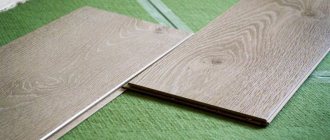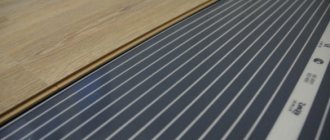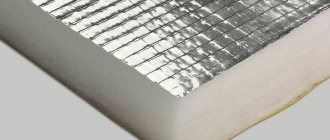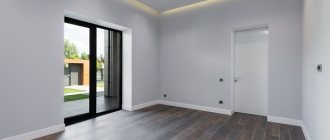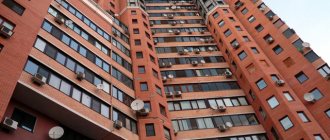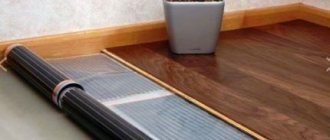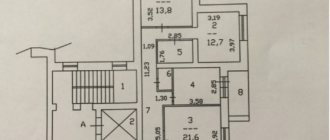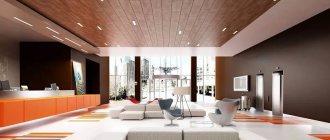The problem of strong audibility in an apartment concerns everyone who lives in apartment buildings. In order to save money, developers do not use sound insulation, as a result of which you can hear what the neighbors are talking about behind the wall. Of course, in order to create optimally comfortable conditions in the house, it is necessary to do complete sound insulation, starting from the floors and ending with the ceiling.
Today, an abundance of building materials makes it possible to carry out soundproofing work quickly and efficiently. One of the main insulation options is flooring. Depending on the coating used, you can select the ideal sound insulation. In this article we will look at how to make sound insulation under a laminate flooring.
Why do you need floor soundproofing?
When a person comes home after a hard day at work, he wants to relax and be in silence. Unfortunately, this is very difficult to do in an apartment. Thin walls do not fully retain sound waves, making it impossible to rest and sleep. Due to such uncomfortable conditions, health problems may arise in the form of malaise, nervous breakdowns and other diseases. You can save yourself from health problems and ensure comfortable conditions in your apartment with the help of high-quality sound insulation.
@Laminat
As everyone knows, there can be two main types of noise in an apartment: airborne, which travels through the air, and shock, which is transmitted over hard surfaces. For comfortable conditions, it is necessary to insulate the surfaces of walls, ceilings and floors. As for the walls and ceiling, in this case everything is very clear; frame sound insulation solves the problem. A more significant problem is the soundproofing of floors.
Today, an abundance of soundproofing materials allows you to perform work of any complexity, the main thing is to know how and what to do.
Basic materials
What to do when you need to create good sound insulation of the floor on which the laminate is laid, or the walls? What material should I choose for the substrate? To do this, you need to get acquainted with the technological features and their scope.
"Texound"
Such insulation material has appeared recently. Today it has already gained popularity, since with a thickness of 3.7 mm it has excellent sound suppressing characteristics.
The material has a mineral base. This allows installation for insulation:
- walls,
- floor,
- ceiling.
For laminate flooring, such a substrate is considered the best option. Moreover, this material is also used when working with a wooden floor laid on logs, or with a wall. Due to the small thickness, no free space is lost.
Texound material
Mineral wool
Excellent insulation for walls and floors. Available in several types:
- glass wool,
- slag,
- stone wool.
Self-installation of mineral wool on the base is carried out in several ways:
- with lathing,
- without sheathing.
Regardless of the method of laying the insulation material, the work is performed in the same technological sequence.
If the sheathing is installed:
- first, preparatory work is carried out: the base is cleared of dirt, cracks are sealed, preparatory repairs are carried out;
- foamed polyethylene is laid: when working with logs, the step size must correspond to the width of the material slab, the logs must have a thickness not exceeding the height of the sound insulator;
- the slats laid in the initial rows of the sheathing should not touch the wall, the gap is equal to the thickness of the material with which it is laid;
- soundproofing material is placed between the joists;
- then the logs are covered with plywood, the resulting cracks are covered with putty;
- When the putty has dried, laminate or similar flooring is laid.
When there is no sheathing, the installation of the material occurs in a certain technological sequence.
- The base is thoroughly cleaned of dust. Accumulated debris is removed.
- The surface is covered with foamed polyethylene. Connecting the strips using tape. The layer of material must cover the wall by 15 cm.
- Mineral wool sheets are installed along the walls around the perimeter of the room, maintaining a height of 15 cm.
- The floor is then covered with plywood sheets or plasterboard is used.
- The sheets on top are covered with basalt slabs, which are laid close to the wall.
- An additional plywood layer is made. The sheets are fastened directly to the floor, directly through the sound insulator.
- The gaps between the sheets and the perimeter wall are closed with putty.
- When the putty is completely dry, the laminate is laid.
Noise insulation with mineral wool
Cork
This material has excellent sound insulation properties. Cork material is most suitable for laying under laminate. This is an excellent decorative coating with excellent noise-absorbing characteristics, which is also used for wall insulation.
Installation of cork substrate in any form occurs according to several technological stages.
- Preparatory work is underway. The base is repaired, thoroughly cleaned and foamed polyethylene is laid. It should have a slight approach to the wall surface. The height is maintained at five centimeters.
- The strips are connected to each other with construction tape.
- The cork backing is being installed.
- A plywood flooring is laid and secured to the base.
- A laminate covering is placed on the laid plywood sheets.
Cork insulation
"Floating screed"
Among the variety of floor insulation options, a floating screed is considered optimal. By definition, a floating screed is a screed that is not adjacent to the load-bearing walls. A soundproofing board or canvas and waterproofing are laid on the subfloors, after which a screed is made. Thanks to this design, noise transmission can be minimized.
@Laminat
A floating screed has a number of advantages, thanks to which consumers use it to furnish their apartment.
- Simple installation technology. Despite the fact that the manufacturing process is considered complex, everything is quite simple and the work can be completed without the involvement of specialists.
- Soundproofing qualities. As practice shows, with a floating screed the noise level in the room is reduced by 50%, which is especially beneficial for people living in multi-storey buildings.
- Damping effect. Due to the depreciation that is formed from the material, it has a positive effect on the musculoskeletal system.
- Sound insulation also provides thermal insulation properties, which helps reduce heat loss.
- Durability of the screed. Regardless of the operating conditions, the service life of a floating screed is calculated in decades.
- Leveling effect. Using a floating screed you can level out uneven surfaces.
Using floating screed technology in an apartment, you can achieve good heat and noise insulation, while the main thing is to choose the right insulating material that will meet the requirements and characteristics.
The difference between noise and sound insulation
For the average consumer, the concepts of sound insulation and noise insulation are equivalent. When looking for protective materials, buyers do not pay attention to what class they belong to. Although, due to the advent of fundamentally new finishing coatings, this difference has become obvious, it is necessary to determine what exactly is required - noise insulation or sound insulation under the laminate.
Sound is air vibrations with a certain frequency and amplitude. Its source can be called structural and acoustic noise:
- elevator movement,
- doors slamming
- human voices, dog barking.
Sound insulation is the complete or partial damping of a sound wave. The operating principle is based on reducing the amplitude of wave vibration due to the porous structure of the material.
The noise consists of several sounds of varying strength and origin and has a shock character. Sound insulation is required to protect against exactly this type of sound:
- clatter of feet, steps;
- falling of heavy objects;
- moving furniture.
Owners of apartments in storey buildings are trying to protect their peace from sounds penetrating from the street, through structural elements of buildings, and from neighbors, by purchasing and installing protective materials. But if the choice is incorrect, the noise will remain.
For sound insulation, materials with a reflective effect are needed, and for sound insulation, materials with an absorbing effect are needed. These qualities are not always combined in one type of building materials. Therefore, with proper protection from extraneous noise of any origin, it is necessary to combine different types of insulation with layer-by-layer installation.
Laminate underlays and sound insulation
Recently, more and more people are choosing this type of flooring as laminate. This coating has an attractive appearance, is made from high-quality materials and does not harm households. Despite all the advantages of the coating, it also has its disadvantages. Due to its high density, the laminated coating transmits dull sounds even when walking on it. To reduce the noise level, a substrate is used.
Currently, there are many different substrate options that can be selected according to certain parameters and characteristics. In order to figure out which one is best suited, you need to consider all the available options.
Polyethylene foam backing
One of the most common substrate options is polyethylene foam. In turn, foam propylene substrates can be conventional or chemically cross-linked. If we talk about the quality of sound insulation, then it is not high, but at the same time the canvas well muffles the sound generated inside the room - slamming doors, loud walking and talking. To increase the efficiency of the substrate, it is necessary to use a multi-layer design.
@Laminat
Cork substrates
This insulating material is made from the bark of the cork tree. It has high performance and soundproofing characteristics. The porous structure of the substrate provides effective sound insulation of sounds coming from inside and outside. The product is made from natural raw materials, which makes the substrate an environmentally friendly soundproofing material. The only disadvantage of this canvas is its cost, which is quite high.
@Laminat
Production technology
The synthetic fiber base is treated with a mixture of bitumen-polymer binder on both sides, onto one of which a layer of sound insulation made of polyester fibers is glued. To prevent the layers in the roll from sticking, a polymer film is applied to the surface of the bitumen layer. To give the material the necessary elasticity, special additives based on butadiene styrene are introduced into the bitumen mixture.
The higher price of Shumanet-100Hydro compared to conventional Akuflex is justified by the presence of a waterproofing layer.
Combined substrates
One type of substrate is a multilayer structure, consisting of two layers of polyethylene plates filled with polystyrene foam balls. The substrate itself is not the optimal solution, since it is subject to deformation, but if it is used as one of the layers, the ideal solution will be obtained.
@Laminat
Insulation boards
The professional type of substrate is an insulating board made from wood fiber raw materials. This backing material is presented in the form of high-density slabs. Due to the density of the structure, maximum sound insulation effect is ensured. Considering the fact that the backing boards are quite hard, they are an ideal coating for leveling the surface and providing a high degree of sound insulation. The main thing when working with slabs is to use soundproofing tape at the seams, then you can get a good result.
@Laminat
Why do buyers choose us?
- We will quickly deliver your chosen Schumanet throughout Moscow and the region. You won't have to wait in a long line, because we have our own fleet of cars.
- Our consultants will help you choose a product for free based on your wishes and budget. You can rely on them as they are experienced acoustic engineers with over 10 years of experience.
- bez-shuma.ru is an official dealer of manufacturing plants. This allows us to set reasonable prices for quality products.
- If for any reason you still have the goods or are damaged, we will take it back from you independently and at our own expense.
- If you find the same product at a lower cost, we will give you a good discount and you can buy building materials even cheaper.
To order products presented in our store, call or. We are glad to cooperate with you!
Shumanet is one of the first and most famous trademarks on the construction market. Introduced to the market in 2001. Nowadays, under the Shumanet brand, premium sound-absorbing materials are produced on a glass or mineral basis with manual quality control of each slab (Shumanet-SK ECO, Shumanet-BM), especially for the Leroy Merlin retail chain - the new generation mineral slab Shumanet-SK Neo, as well as high-quality roll sound insulation for the installation of floating floors on high-quality synthetic fiber with a bitumen coating (Shumanet-100 Combi and Schumanet-100 Hydro). The materials are produced in Russia.
Note! Due to the wide popularity and high demand for Schumanet materials, they are often counterfeited. Be carefull! Purchase soundproofing materials only from certified dealers.
Felt-coated cardboard
This type of substrate is the optimal solution for rooms with dry air. This fabric is considered professional and effectively insulates the room from noise. The only thing that is important to consider is that the product is made on the basis of cardboard, that is, exposure to moisture is undesirable. This substrate is not recommended for use in the bathroom, toilet and kitchen.
@Laminat
"Floating floor"
In terms of efficiency, floating floors are among the best. They can reduce sound levels by 50%. Floating floors are made using soundproofing slabs and concrete screed. The insulation is laid on the rough surface of the floor, and a vibration-proofing pad is made at the junction with the wall. Thanks to this technology, the floor does not come into contact with the walls with a rigid screed, so vibration and other types of noise cannot be transmitted.
@Laminat
Depending on the substrate used, you can select the ideal material that will completely protect not only your home from noise, but also prevent sounds from entering the apartment on the lower floor. The weight of the finished structure is relatively small, so no additional reinforcement of the floor is required.
Isoflex and isolon
The properties and characteristics of the canvases are quite similar. They are made on the basis of foamed polyethylene with a thickness of two to ten millimeters. One of the surfaces of the canvas has a foil surface. These substrate options are used mainly for private construction and renovation. The main advantage of the product is its low cost. The materials are ideal for doing sound insulation on your own. The low weight of the roll allows it to be easily transported and laid in accordance with the requirements of the master.
@Laminat
In addition to technical characteristics, the products have a number of advantages, including: resistance to rotting, does not require special tools for installation, everything can be done independently. The material is often used in complex soundproofing of a room as one of the layers, since the insulation characteristics are low.
Advantages and disadvantages
Sound insulation “Shumanet” is one of the best materials in terms of acoustic and consumer properties. According to customer reviews, soundproofing boards reliably protect the room from extraneous sounds. They also have stable geometric dimensions and a uniform structure. “Shumanet” is resistant to power loads, high humidity, and temperature changes. Other advantages of the material include:
- small thickness and light weight;
- high quality of finished products, ensured through constant testing of the properties of input raw materials and finished goods;
- high sound and waterproofing performance;
- eliminating the risk of shrinkage after installation;
- environmental cleanliness;
- resistance to aggressive chemicals;
- Possibility of installation on any type of surface;
- convenient packaging of the material, ensuring ease of transportation and storage;
- long service life and high wear resistance.
However, this material also has some disadvantages. Its disadvantages include complex cutting and the possibility of installation only at positive temperatures. The disadvantages also include the mandatory compliance with certain storage conditions.
The stoves should be kept in dark and dry rooms. It is important to avoid exposure of the products to moisture and direct sunlight. If these conditions are not met, the quality of the product and its consumer properties noticeably deteriorate.
“Shumanet” is a group of soundproofing materials that differ from each other in technical characteristics and performance qualities. To produce different types of products, different raw materials are used and special production technologies are used. One of the very first and inexpensive soundproofing materials is Schumanet 100.
The basis of the canvas is fiberglass, treated on one side with a bitumen-polymer composition. This is a rolled product, which is most often used for arranging interfloor ceilings. Later, the manufacturer created several more soundproofing products developed on the basis of Schumanet-100. These include several groups of goods.
- Schumanet 100 Combi. This material is obtained by double-sided processing of fiberglass panels with a bitumen-polymer composition. In addition, one of the sides is finished with a specialized soundproofing material, which increases noise suppression. “Combi 100” is designed not only to increase the sound insulation of a room, but also to protect it from moisture.
- "Shumanet 100 Hydro". This is a rolled product that consists of two types of different layers: fiberglass and a damping panel. In addition to noise reduction, it performs the function of waterproofing.
- "Schumanet 100 Super". This is an innovative soundproofing product designed for objects with class A comfort level. It is often used to install floating floor systems.
"Tuplex"
The product has a three-layer construction and is used as a substrate for laminate. The bottom layer of the product is made of polyethylene, which allows moisture to pass in one direction. The middle ball is made in the form of styrene balls, which give a sound insulation effect, and the third layer of duplex is made of thick polyethylene film.
@Laminat
Using the coating, the coating slats do not creak, and the locking locks do not become loose. This substrate effectively retains sounds and neutralizes them. Thanks to the structure of the slab, it can be used in rooms for any purpose, even in the bathroom and shower.
The three-layer underlay provides a high degree of heat and sound insulation, which in turn is the optimal solution for the floor covering as a whole.
Types of sound insulation
Despite all their advantages, laminated boards have a very significant drawback - noise occurs at the slightest movement on such a floor. The reason is that this flooring has a very dense structure, so sound travels unhindered and instantly across the entire surface.
It will not be possible to completely eliminate the problem, but soundproofing the floor with special underlays for laminate will help reduce the noise level. They have the necessary insulating properties, but to varying degrees. Therefore, when choosing a material, you need to make sure that this is the option that will make the laminate almost silent.
Expanded polystyrene
The backing is made of extruded polystyrene foam, available in sheets or rolls. Main positive qualities:
- lasting,
- with low thermal conductivity,
- resistant to fungi and bacteria.
Reasonable price and good soundproofing properties make it indispensable for the substrate under laminate when forming a “floating floor”. The base must be perfectly flat, because polystyrene foam is not able to smooth out surface defects of more than 2 mm.
How to make a base floor level, read the article “The best ways to make a laminate floor perfectly level”
Isoflex and isolon
These are related materials with similar properties. They are foamed polyethylene covered with a layer of foil or lavsan. Available in roll form. They combine certain advantages:
- rot resistance,
- ease of installation,
- low price.
But they also have a number of disadvantages:
- short-lived, lose their thermal insulation properties after a few years,
- not suitable for installing heated floors,
- lose volume during operation (compressed).
In addition, the noise-insulating properties are rather conditional; isoflex and isolon only reduce the volume of knocking.
Isopor (extruded polypropylene)
It has the same qualities as isoflex - it has its pros and cons. Sound insulation based on isopor is better; it almost completely dampens sounds inside the apartment - steps, slamming doors, conversations, but it provides little protection from the voices of neighbors on the lower floor or street noise.
Isonoise
Trade name for soundproofing systems based on foamed foil polystyrene foam. One of the best materials for soundproofing the floor in an apartment, especially laminate. Strong, durable, does not cake and does not deform after long-term use. Available in the form of sheets 3-5 mm thick. It dampens sound waves from TV, loud conversations and music well, and reduces the clinking of dishes. Does not allow heat and moisture to pass through. The disadvantages are the high price and complex installation.
Mineral wool
It is fibers made of glass or basalt, pressed into slabs or rolled into rolls. The level of density of the material determines the heat and sound insulation performance; the denser the slab, the lower the noise level in the apartment.
The advantages include:
- light weight,
- non-flammability,
- natural origin,
- affordable price,
- convenient installation.
Among the disadvantages, one can note a noticeable increase in the floor level during use, mandatory compliance with safety measures when working with mineral wool to protect against the smallest fragments of artificial fiber.
Note! Mineral wool is not used as a substrate for laminate flooring. Due to its thickness, it is used in cases where it is possible to raise the floor by 10 centimeters or more.
Fiberglass "Shumanet 100"
Construction technologies do not stand still; new materials are appearing that have a high degree of sound insulation of the floor in an apartment with laminate. Fiberglass is one of them. This is an improved version of glass wool, but unlike it, it has a number of serious advantages. Fiberglass is impregnated with bitumen and organic resins, which creates an excellent insulating layer not only from noise, but also from moisture. Fiberglass has the following beneficial properties:
- does not raise the floor level, having a thickness of only 4 mm,
- installation can be done independently
- safe for health because it does not crumble,
- has good noise insulation properties due to its multi-layer nature.
The material belongs to comfort class A and is used in the construction and finishing of luxury houses. A high price in this case is a sign of good quality.
Expanded clay
Ceramic granules are used for screeding, simultaneously serving as a soundproofing layer. Dry screed forms a fairly dense layer, which simultaneously serves as heat and sound insulation. For semi-dry and wet screeds, expanded clay with the same granule size is used, which makes the layer looser, and the sound insulation in this case is higher.
The material is not a substrate for laminate, but can perform sound insulation functions.
It is practically not used in apartment buildings, because it significantly increases the floor level. Convenient in private housing construction, where ceiling heights are not regulated.
Cardboard with felt
Cardboard with felt, like wood, has good heat and sound insulation properties, but is afraid of moisture. Therefore, it cannot be used in rooms with humid air. It is used in professional insulation, is expensive, and is used infrequently.
Akuflex
Artificial soundproofing material. It is a roll covering made of polyethylene coated with polyester fiber. The elasticity of the akuflex helps dampen sharp sounds from footsteps and impact noise. This laminate underlay will provide excellent sound insulation for a floating floor. Can be used in both residential and office spaces.
Vibroisotex laminate
Roll material made of polyester fiber, made using special technology. Designed to protect against impact noise and has high sound insulation properties. Mainly used as a substrate when laying laminate flooring using floating floor technology.
Isoplaat
Environmentally friendly slabs made of coniferous wood without the addition of phenolic resins and other harmful substances. They are used to soundproof laminate floors, protect against acoustic and household sounds, and significantly reduce the level of structural noise. They are professional types of insulation and have a fairly high price, so they are rarely used in everyday life.
Tuplex
New insulating material consisting of three layers.
- The first layer, which should be on the bottom, is polyethylene, which has waterproofing properties.
- The second layer, located in the middle, contains styrene beads in a free state.
- The third layer, covering the first two, is a thickened polyethylene film that reliably insulates the styrene granules.
Thanks to this movable structure, the substrate allows the laminate to be positioned with the greatest “convenience” on its surface when environmental conditions change. The locks retain their integrity, the floors do not creak when walking.
Duplex has good insulating qualities - it retains heat, does not allow moisture to pass through and protects from noise. But there are two serious drawbacks due to which the material has not become the most popular in this class of building materials:
- firstly, the high price,
- secondly, toxic styrene fumes.
Although styrene is bound in polymerized granules, only one percent of the free substance released into the air can lead to persistent illness. The only way to avoid this is to ventilate the room more often in which the Tuplex lies under the laminate.
Cork backing
As the name suggests, it is made from compressed particles of cork tree bark. In addition to being environmentally friendly and light weight, cork has a high level of sound insulation, almost does not conduct heat and is able to withstand long-term mechanical loads. When laid under the laminate, the cork backing will prevent the voices of the neighbors below from being heard, and will protect them from the stomping of the upper residents.
An important drawback is that it is hygroscopic, so it cannot be used in bathrooms or bathrooms.
Available in the form of slabs, rolls and cork panels with a lock, such as laminate. Only high cost stops cork from being widely used.
Combined substrate
It is a kind of analogue of Tuplex. Only polyethylene plates act as the outer layers, and the middle is filled with polystyrene foam balls or granules. The soundproofing underlay, which is absolutely safe for health, is ideal for laying under a floating floor. The movable structure prevents the material from deforming or bunching up in one place, which would lead to the formation of sound bridges.
Quiet laminate
Technologies continue to develop; world-famous companies have already begun to produce collections of soundproofed laminate flooring. The noise-absorbing layer is included in the lamella design and reduces the noise level by 60% compared to conventional panels. By adding a sound-absorbing substrate to this, you can achieve almost complete isolation from noise coming from outside and harsh sounds inside the apartment.
Mineral wool
This type of sound insulation is quite common among buyers. The efficiency of the slab is ensured by the random arrangement of fibers. The soft base ideally holds both vibration and air sounds, and the price of the product is not at all high. Mineral wool is made from basalt rock. During the manufacturing process, basalt rock is melted and microscopic fibers are formed using a turbine. Using a binder, the raw material is formed into slabs.
@Laminat
Mineral-based products have high levels of heat and sound insulation, which makes the slabs popular. Using mineral wool, you can perform two types of work at once. Ensure silence and reduce heat loss.
The insulating building material is perfect for soundproofing work on walls, ceilings and flooring. Low price, environmental friendliness and other advantages make the substrate very popular. The only thing such a stove is not suitable for is retaining infrasound.
Fiberglass "Shumanet 100"
One of the most common and popular insulating materials. The level of protection of the material is about 29 decibels. In most cases, this building material is used in luxury construction. The board is based on fiberglass and bitumen resin. The product is produced in rolls, which allows it to be transported and used for repairs of any complexity without any problems.
@Laminat
Due to the fibrous and soft base, the slab retains airborne and vibration noise well, making the room quiet and comfortable. If the work is done correctly, the result of sound insulation will be noticeable almost immediately.
As for the characteristics, the canvas has quite high characteristics, so it can be used both for production workshops and private construction. If we talk about the disadvantages, the main one is the cost of the product. However, if you compare all the pros and cons, then you can confidently say that by installing noise insulation, you can forget about repairs for many years.
Expanded clay
The main use of this material is for the manufacture of dry and semi-dry screeds. Expanded clay granules are porous, which allows it to perfectly absorb and insulate various noises.
By using granules of different sizes, optimal sound protection can be achieved. The main advantage of using expanded clay is its low cost. With a properly executed screed, you can achieve a good effect, while spending a little money.
@Laminat
If we consider the product as an insulating coating for apartments, then it takes up a certain height, which is why expanded clay is rarely used as sound insulation. As for individual construction, in this case this is the optimal solution.
Sound insulation thickness under laminate
Currently, most builders use the outdated 3 millimeter selection system when choosing the thickness of the substrate. The thing is that the substrates used in the last century are significantly different from those used today. If previously, with the thickness of the insulation layer, the lamellas began to sag and squeak when walking, but now the quality of the materials is much higher, which means the thickness of the substrate can be whatever is optimal for you. When choosing the thickness of the substrate for the laminate, you need to pay attention to the following points:
- Characteristics of coating lamellas. The thicker the lamella, the more powerful the sound insulation substrate can be used;
- The degree of elasticity of the insulating material;
- The quality of the floor screed.
When polyethylene foam is used as a substrate, it is important to take into account the degree of compression, so the layer thickness should be at least five millimeters. When using a thicker layer, the effectiveness of sound insulation will increase, and the same applies to thermal insulation characteristics.
Important! If you use a thick but soft layer of underlay, the fastening locks in the laminate flooring will quickly collapse and you will have to completely replace the floor covering.
Depending on the choice of the subgastric layer, the thickness can vary from two to seven millimeters. It is necessary to select a soundproofing layer for the laminate in accordance with the technical parameters of the room. There is no need to overdo it when choosing thickness, as this can negatively affect the coating itself and its service life.
Features of the work
The principle of creating a protective layer under the floor covering is the same for all types of raw materials. Soundproofing substrates that are mounted on the screed are pre-protected with thin polyethylene. The material is folded in strips, making overlaps of 20 cm and overlaps of 2 cm on the walls. All seams are taped. The raw materials are placed perpendicular to the laminate.
The protection must not be installed on a subfloor made of wood. The product is placed on boards or plywood installed on top of the problematic base. The noise-absorbing agent is placed under the flooring between the joists.
Cross-sectional multilayer screed Source acousticstime.com
Laying on screed
In order to install the screed, it is necessary to go through a certain sequence of steps.
- Surface measurement. It is very important to correctly measure the area to be treated. When buying building materials, it is not advisable to take more or less than required; in both cases it will not be profitable. Only accurate measurement will help you take what you need and in the right quantity.
- What material to take. Due to the large selection of soundproofing building materials, it is quite difficult to choose just one. Each of them has its own characteristics and advantages. It is necessary to choose the type of insulation that is suitable in terms of cost and characteristics.
- Preparation of the workplace. All tools and materials should be at hand so that there is no need to collect them throughout the house.
- Preparing the screed surface. It is necessary to cover the entire surface of the screed with plastic film. You can use tape for fixation.
- Choosing the direction of laying the laminate. There are two main ways of laying the substrate, where the first is perpendicular to the wall, and the second in accordance with the location of the lamellas.
With proper preparation, the work process will go quickly and efficiently. All installation work can be done independently without turning to specialists for help.
Extruded polystyrene sheet backing – wide choice of thicknesses
When people ask me what kind of backing to buy, I don’t recommend sheet backing. However, I often put it down. From which we can conclude that sellers are actively working with it, selling it together with laminate.
Sales people explain the advantage of this insulation, compared to foam, in its higher density and service life. Theoretically this is true, but in practice it is unknown. The fact is that extruded polystyrene foam is also a gas-filled material, a little more dense, but brittle and brittle. It keeps its shape better, but by how much is unknown. I met pressed polystyrene foam and foam bedding.
During assembly, lightweight slabs fly apart under air currents, so they need to be secured with tape. Available in different packaging sizes. I recently laid sheet Arbiton; the sheets from one pack were of different lengths. There was no need to talk about the accuracy of the joints.
Expanded polystyrene in Maxidom in the form of an accordion
The speed of laying sheet material is significantly lower. Once, while ordering, he suggested that the girl, to save money, lay out the sheets herself and fasten them with tape, showing how it was done.
The speed of laying laminate flooring was not inferior to her. She said several times: “Alexander, you are breathing down my back.” I imagined myself as a skier on the piste.
Plus sheet polystyrene insulation in a large selection of thicknesses - 2,3,5,7 mm. The foam analogue also has linings of different thicknesses, but due to the soft structure, I would not recommend using more than 3 mm.
The average density of extruded polystyrene foam is about 35 kg/m3. The price of the substrate is about 50 rubles/m2.
I could lay it myself to level the floor with tiles, taking a thickness of 5-7 mm. Or if it is impossible to knock down cement deposits on the base, using 5 or 7 mm slabs. I would not use 3 mm polystyrene. It’s better to take Tuplex or Profitex then.
